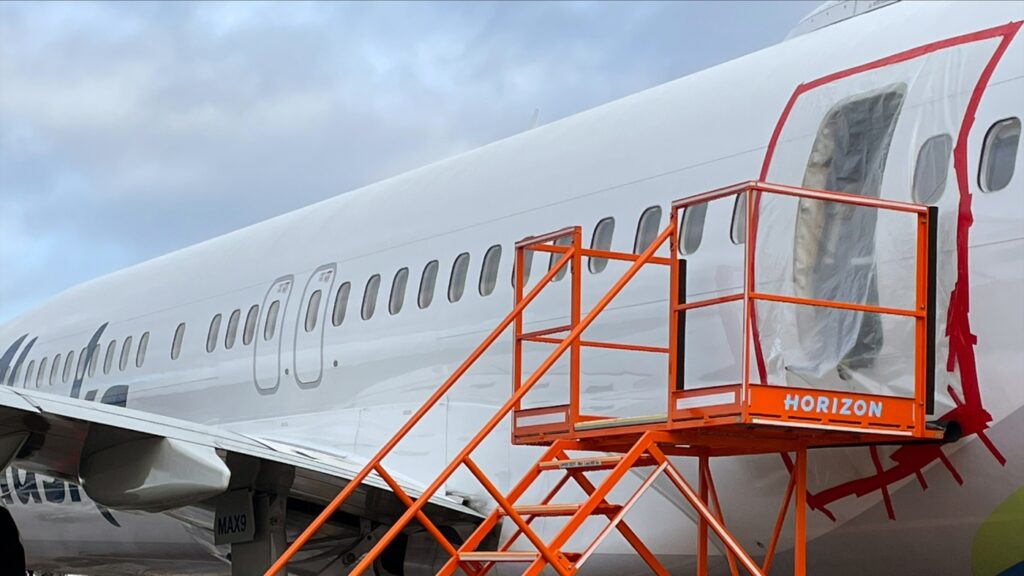
PORTLAND, OREGON - JANUARY 7: In this National Transportation Safety Board (NTSB) handout, plastic covers the exterior of the fuselage plug area of Alaska Airlines Flight 1282 Boeing 737-9 MAX on January 7, 2024 in Portland, Oregon. A door-sized section near the rear of the Boeing 737-9 MAX plane blew off 10 minutes after Alaska Airlines Flight 1282 took off from Portland, Oregon on January 5 on its way to Ontario, California. (Photo by NTSB via Getty Images)
WASHINGTON — The National Transportation Safety Board (NTSB) has identified multiple systemic failures at Boeing and the Federal Aviation Administration (FAA) that led to a midair door plug blowout on a Boeing 737 Max jet last year. The incident, which occurred shortly after takeoff on an Alaska Airlines flight, did not result in any fatalities or serious injuries, thanks to the crew’s swift action in returning the plane to Portland International Airport.
Immediate Impact
NTSB Chair Jennifer Homendy commended the flight crew for safely handling the emergency involving 177 passengers. “This accident never should have happened,” she stated, emphasizing that the safety deficiencies should have been apparent to both Boeing and the FAA.
The January 5, 2024, incident raised significant concerns about safety and quality control within Boeing. Seventeen months later, the NTSB convened in Washington to present their findings and determine the probable cause of the accident.
Key Details Emerge
Investigators revealed that the door plug panel was reinstalled at Boeing’s factory without the necessary four bolts to secure it in place. The absence of even one bolt could have averted the blowout on Alaska Airlines Flight 1282. These bolts were never recovered, leading investigators to believe they were discarded.
“Boeing relied on a single point of failure, which was a human not filing or documenting a record. That was a flaw in the system.” — Jennifer Homendy, NTSB Chair
The NTSB previously disclosed that the bolts were missing when the aircraft was delivered to Alaska Airlines in October 2023. Boeing’s lack of records on who removed and reinstalled the door plug highlights deeper issues in their safety protocols.
Industry Response
Following the incident, Boeing’s former CEO Dave Calhoun announced his resignation, and the company replaced top managers at its Renton, Washington factory. Boeing has since implemented enhanced training for new employees and returned to a production rate of 38 jets per month.
Current CEO Kelly Ortberg expressed regret over the accident and reaffirmed Boeing’s commitment to improving safety and quality. “We will review the final report and recommendations as we continue to implement improvements,” the company stated.
FAA Oversight
The FAA has increased its oversight of Boeing’s 737 Max production and temporarily capped manufacturing at 38 planes per month. “The FAA has fundamentally changed how it oversees Boeing since the Alaska Airlines door-plug accident,” the agency noted, pledging continued rigorous oversight to ensure safety and quality.
By the Numbers
– 177 passengers safely returned to the gate.
– 4 missing bolts led to the blowout.
– 38 jets per month production cap imposed by the FAA.
What Comes Next
Both Boeing and the FAA have reportedly improved their safety processes since the incident. Homendy praised CEO Ortberg for renewing the company’s focus on safety, though she acknowledged that further work is needed.
This incident is a major setback for Boeing, which is still recovering from the fallout of two deadly 737 Max crashes in 2018 and 2019 that claimed 346 lives. The Department of Justice recently reached an agreement with Boeing to drop a criminal case related to those crashes, despite objections from victims’ families.
Background Context
The blowout occurred six minutes after takeoff as the plane climbed to 15,000 feet. Had it happened at cruising altitude, the outcome could have been catastrophic. “Frankly, it’s nothing short of a miracle that no one died,” Homendy remarked.
The incident underscores ongoing challenges for Boeing as it works to rebuild trust with regulators and the public. The company’s efforts to address systemic issues will be closely monitored as it seeks to maintain its position in the aerospace industry.







